
A butterfly’s metamorphic process is a grueling journey of self actualization. At first, a tiny egg, then a glutinous, ravenous larva, then a sedentary cannibal. The caterpillar’s body digests itself from the inside out using the same liquids it once used to digest food as a larva to break down its own body into imaginal cells. To the outside observer, the cataclysmic process appears as two weeks of stasis, only to emerge as a miraculous, and majestic butterfly. Before it can take off fluttering with frenetic freedom, the butterfly secretes meconium, a liquid that contains the extra waste from its chrysalis stage. This respite is the final release before a new life can begin–before metamorphosis is achieved and the butterfly can go on to pollinate, procreate, and eventually pass away within days or weeks. The meconium, which varies in color depending on its state of health and the butterfly, becomes the last piece of evidence that the butterfly was once a larva, a stamp on its way out of one era and the beginning of another.
This transformative process is continuous inside the tessellated triangles of artist Franky Cruz’s geodesic Viviarium Meconium Lab. Dozens of native host and pollinator plants–milkweed, corkystem passionvine, and more, fill the 12-foot hemisphere. Above them are the fluttering butterflies that feast on their leaves and flowers during different life stages. Cruz, who was born in the Dominican Republic and raised in Hialeah, Florida, uses the space to raise the larva free from predators, such as parasitic wasps, lizards, and harmful pesticides. As they transform, he collaborates with the creatures to create art, forming part of what he calls the Vivarium Meconium Lab.
With excruciating delicacy, Cruz pins the chrysalis’ connective silk to a mesh board he rigs above a canvas. The butterflies, suspended over a large watercolor canvas, will emerge, splattering their meconium like an instinctual ink blot–nature’s Jackson Pollock. When their wings dry and the meconium has waned, Cruz releases the butterflies back to their native environment. The meconium in turn becomes a sustainable, and regenerative, natural pigment, and the otherwise ephemeral moment is rendered permanent.
On a Wednesday morning in early May, Cruz’s Dome Lab was tucked away in the Miami Beach Botanical Garden’s lush secret garden. For one week, guests at the Aspen Ideas Festival and serendipitous passersby were treated to witnessing Cruz tend to his garden lab–watering plants, combing through branches for larva, and engaging with the public about the importance of supporting native wildlife, especially in a city vulnerable to climate change.

Initially inspired by a 2015 trip to witness the Monarch migration in Mexico, Cruz has been formally cultivating the Vivarium Meconium Lab since 2017 when he repaired butterfly wings as part of a performance at Locust Projects. At the time, he wanted to bring that sense of nurturance to a space he felt was devoid of any love, empathy, or care for anything other than capital or status. Eventually, the butterflies returned to his studio, laying eggs on his host plants, and they began a symbiotic relationship.
“Once the caterpillars were in my studio, we started working together,” Cruz said.
He noticed adult caterpillars crawling over electrical cables and in odd corners of his studio preparing to chrysalis. One morning, he watched as one emerged from his windowsill, leaving behind a faint splatter.
“I thought, I could clean this up or I could slide a watercolor paper on there,” Cruz said. “Nature’s already making beautiful art.”
Thousands of butterflies later, the Lab has grown from a plexiglass box to a 12-foot geodesic dome inspired by theorist and architect R. Buckminster Fuller’s patented design. Cruz spent five days assembling the dome–which had been fabricated offsite–under the glaring sun with help from a friend. Cruz wanted to bring Fuller’s work into conversation with his own ideas of conservation–Fuller believed humans should view the planet as a spaceship flying through space and with continual maintenance in order to sustainably operate. In Miami, where climate change and sea level rise are undeniable, the message could not be more poignant: Cruz’s Lab is a reminder to treat our fragile city with care.
“We’re on this planet with limited resources,” Cruz said. “I was already thinking that I don’t want to consume more, I don’t want to make more objects.”
After so many years spent surrounded by constant transformation, Cruz has wondered about the correlation between himself and his insect friends. Maybe humans are akin to the larval and chrysalis stage of a butterfly–continuously consuming until they reach immobility. Or, perhaps, he says, a more apt comparison would be how Miccosukee people go through naming rituals throughout their lives for major life events.
“Those rituals are important, we’re not the same,” Cruz said. “I’m not the same person I was last year, I’m not the same person I was yesterday, I’m not the same person I was before building this dome.”
As the Aspen Ideas Conference came to an end, Cruz deconstructed the edifice he’d toiled over for five days, turning it in on itself. The Dome Lab will go dormant, slumbering in a storage unit, until Cruz can determine where to set up his own personal lab, or find funding for a permanent host space. Cruz hopes the Dome will land permanently in his hometown, Miami, but the city’s unsustainable rental market’s new heights have proven to be inhospitable for artists, prioritizing instead a wealthier tech class. Until then, Cruz will continue to raise and release butterflies into Miami’s ecosystem, each one intentionally cared for and charged with the power of metamorphosis.

This piece was published in partnership with Oolite Arts as part of a project to increase critical arts coverage in Miami-Dade County.




